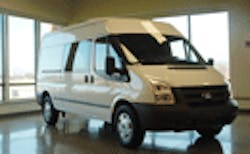DEARBORN, MI. For those who can’t wait to see the full-size Transit van from Ford Motor Co., you may only need to look out your window the next time you hit the highways. That’s because Ford announced that the European vehicle, slated to begin production in the U.S. in 2013, is already here and in some select customer’s hands for testing.
Ford held a media briefing at its Dearborn headquarters this week where it provided an overview of its commercial vehicle lineup, an update on production for its F-650 and F-750 vehicles, and a glimpse at the Transit, which the company had on hand for viewing.
(See photos of the current European model of the Ford Transit.)
“Our ‘One Ford Plan’ is a plan that started [five years ago] as a global plan, not a regional plan,” said Derrick Kuzak, group vice president-global product development. “It’s only natural that we extend that plan to our commercial vehicles with the Transit as a global van.”
The Transit, which Ford announced would be built at its Kansas City Assembly Plant starting in 2013, has been a global success for the company, selling more than 6 million units since its debut in 1965. Ford plans to phase out the E-Series cargo van throughout the next decade, replacing it with the Transit as part of its overall strategy to reduce the number of vehicle platforms it offers to around 12 by 2014. A few years ago, Kuzak said, that number was 27. The company estimates that over 80% of its global vehicles will be covered by the 12 platforms.
Ford is making a $1.1 billion investment in the Kansas City Assembly Plant to produce the Transit, Kuzak added. While specific details on the vehicle, such as powertrain options, have yet to emerge, Tim Stoehr, commercial truck marketing manager, told Fleet Owner that there will be “multiple configurations for multiple applications” in the U.S.
When it debuts, the van will represent the “next generation of the Transit,” Stoehr said, and would be a truly global vehicle, modified slightly for individual markets. In Europe, the van is offered in three roof heights, four lengths, and with three diesel engine options and in cargo, passenger and chassis cab configurations.
The E-Series van that the Transit will eventually replace has been Ford’s best-selling commercial van for more than 32 years.
“E-Series really has been our commercial workhorse,” said Rob Stevens, chief engineer-commercial truck. “It is well over half of the van market today. The E-Series van is really focused on the commercial market.”
One big advantage of the new Transit, Ford said, is the weight savings over the current E-Series model.
“The weight savings is at least 300 lbs., which translates to improved fuel economy,” Kuzak said. “That’s what it’s all about, substantial savings to the bottom line of our commercial customers.”
That weight savings should translate to about 25% better fuel economy than a similar E-Series van, Ford said.
Ford is building a new test road at its Michigan Proving Grounds to simulate the expected conditions and applications that the Transit will face here in North America.
(See video of Ford’s Transit undergoing the testing process.)
Ford also announced that its F-650 and F-750 vehicles, currently made in Mexico under agreement with Navistar, will be manufactured at Ford’s Ohio Assembly Plant, which now produces the E-Series van. Ford and Navistar have discontinued their Blue Diamond Truck LLC joint venture. The Ohio plant will also produce the E-450 stripped chassis, which Ford will continue to make even after phasing out the E-Series cargo van, as well as the company’s F-53 and F-59 stripped chassis products.
“It really is about dedicating that plant to the commercial industry,” Kuzak said.
Related content: Photos of the current European model of the Ford Transit
